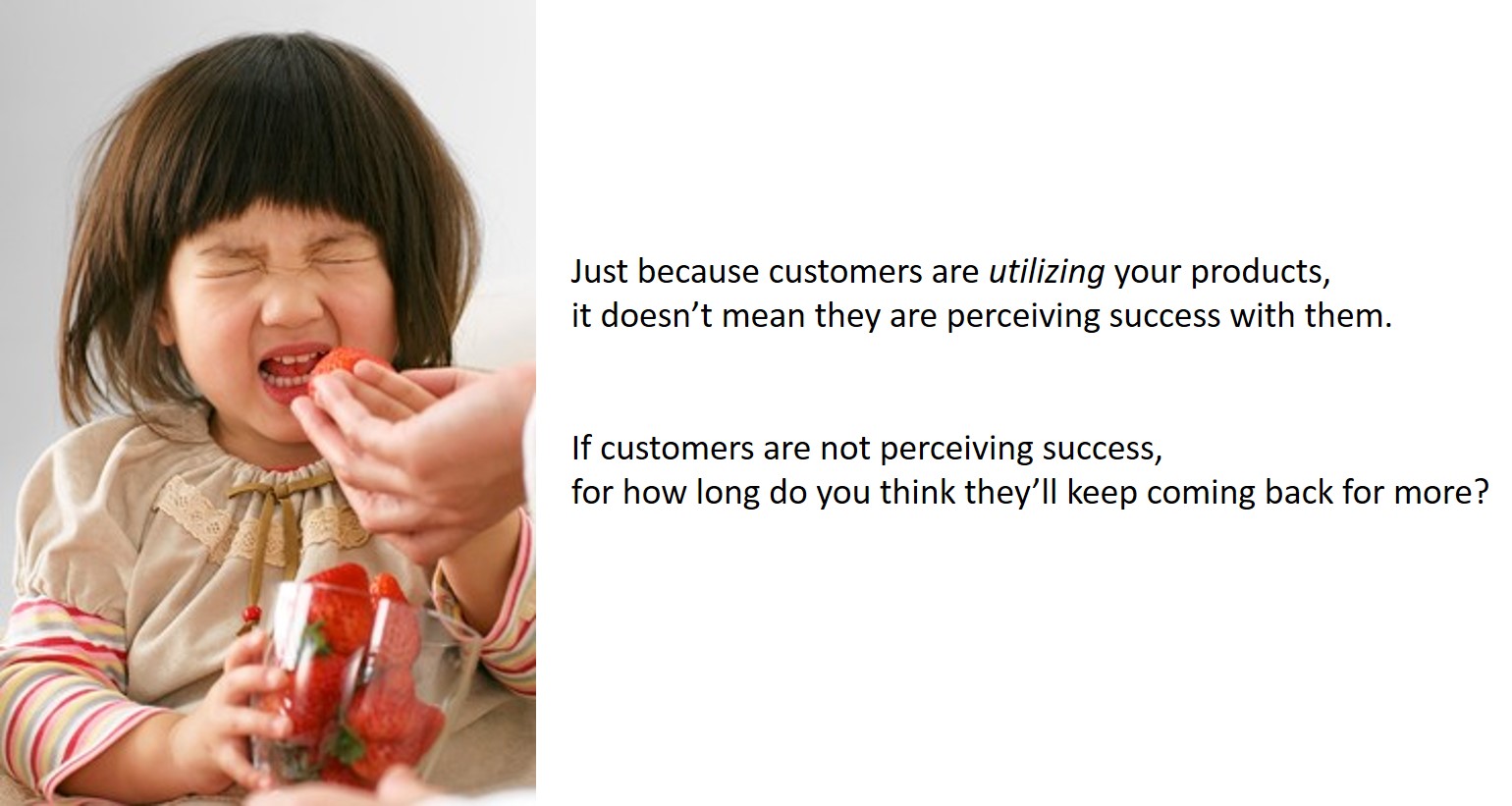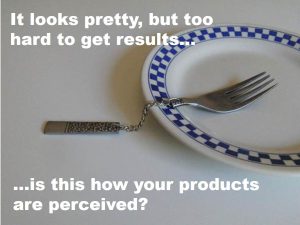Search Waypoint Resources
5 Ways B2B Companies Can Accelerate Growth (Part 2)

Utilization ≠ Adoption
Welcome to the second installment of this series about accelerating growth in B2B. I started this series by illustrating how retention is the cornerstone of growth and how improved expansion from a deeper footprint in accounts can accelerate that growth.
Today I’m focusing on “accelerating growth method” #2: Improved retention from a ‘business results’ orientation with your customers. Summary: Each (key) account should have an identified Champion, and it is critical to ensure your company is aligned with your Champions’ definition of success in order to leverage that person as a key way to receive information and engage with other contacts in your accounts. But your Champions’ definition of success may not be sufficient, and if you truly want loyal customers then drive to business results.
What is a ‘Business Results Orientation?’
Unless your product is a true commodity, B2B purchases nearly always need ‘change’ to get the results for which they are purchased. Once the product has been bought and the implementation cycle and on-boarding has ceased for your company, the ongoing process has only just begun for the customer. What this means is that although your major role has now been completed, your customer now has to deal with a brand new product and the challenges that go along with that. The capabilities of the product may outshine everything the company has worked with previously and allow for improved profitability and productivity, but if change isn’t embraced it will be as useful as a new car in a room of people that can’t drive; nice to sit in, but not really what it was designed for.
So your customers need to adapt to the new capabilities of the product they’ve just purchased and this can mean making sure that they’re using it correctly. It is extremely hard to measure value in a product you’re not actually using to its full potential. Take that car example: The seats are quite comfortable and the radio isn’t bad, but if seating and sound are the only use you have for it, your customer will see no value at all from their investment. If the products that you have sold your customer aren’t being implemented properly over a long-term, then don’t hold your breath on retention.
CRM software is a great example of this, as nearly every company has it. The problem arises when the software has been purchased and nothing changes. Unless the new software is truly adopted by employees – not just used – no value or change will be seen. This then reflects poorly on the software, somewhat unfairly, when leaders state, “We paid $x for this software and we aren’t seeing the extra profit we were promised, it clearly doesn’t work.”
The breakdown of the software capabilities isn’t wrong, there’s nothing wrong with the installation, but the users are the component which has failed to adapt… who’s fault is that? I’ll rephrase: who’s in the best position to be able to help drive adoption? You, your customer, or both? Since you are in the position to see how success is realized across your customers, surely the answer must be that both parties have to be responsible for success. Yet far too often vendors sit back and make success the customers’ problem. This is a recipe for churn.
You sold your products and services to a customer account and as such they have bought into your message and brand. They need to see results for the purchases they made, and more importantly you need them to see results. They have staked their reputation on your company, and you are now merged in vested interest with each other.
Some CS teams need to take a long hard look at their processes in this matter, especially when it comes to collecting data on customer adoption of products. For many it isn’t customer success, which is being monitored by your CS team, rather it’s vendor success. You might believe you’re measuring adoption, but you’re probably measuring utilization (usage of features/modules), which is certainly not the same as true adoption. In other words, you’re measuring your own success as it masquerades as the customers’. You’ve sold the product and you’re making money on it the more it is used. But the problem is that regardless of this usage rate, you have absolutely zero information about how well the customer is accomplishing business tasks with it, if its meeting expectations and more importantly if the customer is seeing value. Data may be flowing into your Customer Success team indicating that your customer spent all day, every day on the product, which for you is equaling success.
But stop!
What if they’re using your product without changing associated business practices, rendering the product largely useless? What if the customer has spent time addressing problems they’ve experienced and in actuality work is taking longer than it should? What if three different users have attempted to fix the same problems? So while CS teams are delighted with the level of product utilization, the customer is having anything but success with it. The crucial point: the CS team doesn’t know this because they either haven’t asked or they haven’t gotten a response to those silly surveys.
Customer success and vendor success are not the same things. True, what’s good for you can also be good for your customer. But if you’re meant to be focusing on the success of those you’ve sold to, then you better find out if the data you’re collecting is trustworthy and ask the right questions of the people who know. (To further understand how to properly measure the success of your customers see our post on Customer Success Metrics.)
For customers to see success and value, they need to adopt to the product they have bought so they can realize the benefits and reap the rewards. Utilization ≠Adoption
Why does a “Business Results” Orientation Work?
It works in three different ways:
- Most of the decision makers and key purchase influencers in your customers’ buying committees may not actually be aware of the true scope of the product. They may only have seen demos or specs but haven’t fully assessed how it could help their business since that the job of their teams. You need to ensure that your buyers are in no doubt of the tremendous value you can bring to them. But you also need to be sure you are aligned on a mutual success plan. What will you be providing in order to help the customer truly adopt to your products? And what will the customer need to provide… and do they know it?
- Ensure you strengthen your customer relationship with your key contacts by helping their career growth. They have staked their reputation on you, it seems only fair you reciprocate when you can. This could include ensuring they’re aware of options of added value, networking potential, and (non-monetary) incentives for advocates (think exposure, networking, and recognition).
- Show your customer where it’s worked before. For this make sure you have relevant case studies on hand of another company you’ve worked with, whether you redact their name or not. Show your customer exactly how you worked with them, the value they saw, and the milestones you hit. Show them what you did, and show them what the customer did. Remember, if you did a great job with another company don’t be afraid to shout it to the world! Ask your contacts within truly successful accounts for a review that you can share.
How a “Business Results Orientation” Works
To fully understand how it works you need to know how your B2B company defines success for your customers. The easiest way to think of this is to know what metric your company ‘owns’ that delivers proof points.
Let’s use Waypoint as an example. Readers will know that we are focused on helping companies achieve a high (60% – 70%+) participation rate from customer feedback requests. This is because we know that a great many indicators and growth accelerators come with high participation rates. So for Waypoint, owning this metric differentiates us and more importantly, our capabilities. The key thing about participation rates (and great metrics in general) is that they can measure the level of customer-engagement for our clients.
When you have isolated your primary metric the business benefits that come with it are now measurable. For example, if your B2B company’s solution improves First Contact Resolution (FCR) due to better reverse logistics, then you will have to show your customer how you have improved FCR and the associated business benefits which go along with that, including cost savings from fewer repeat contacts and better customer loyalty from easier handling (for example measured in repeat purchases). This extends beyond your internal metrics though, as your B2B customer will surely have ways that they measure your success. It is crucial to ongoing success for both the customer and you that you know what those metrics are.
It is also pivotal to the health of the account that you talk to your account team and understand what the customer’s expectations are. How the product was sold to them will give you an insight into the expectations they will have for the future. If your Accounts or Sales teams haven’t documented the sales pitch, ensure you have a thorough understanding and document it yourself for any future issues. Have you created a joint plan of attack with the account in question? Why not? Deliverables agreed upon by both sides and tracked accordingly can ensure expectations are grounded in reality so both you and your customers are happy.
Help is something which should be offered accordingly. If the customer account isn’t able to move the needle on their metric, then they’re going to need some assistance. Especially if you don’t up-sell for such assistance, it may seem like additional energy expenditure to start providing more assistance to customers but in fact it can be an incredibly smart move. Imagine this: You don’t provide any help and passively let your client ‘muddle along’ unaided, failing to meet their metrics. What will happen? Most likely the lead will change in the company due to a lack of business results. The account will churn. By contrast, helping your customer to be successful, will not only build loyalty but also an advocate.
Evidence that a “Business Results Orientation” Works
Research consistently shows that improving customer ‘sentiment’ also improves customer loyalty, and loyal customers stay longer, buy more, and tell their colleagues. Actually this isn’t surprising…how many of us have a favorite coffee shop that we frequent? The friendly baristas that remember your name, the coffee is great and the loyalty card provides terrific benefits. We tell our friends, we hold coffee meetings there, and we are loyal because we feel positive toward the business. Loyalty doesn’t just work with favorite coffee shops. The sentiment a customer has for your business can protect their loyalty.
Perhaps you are unsure how vital the role of sentiment is. If that’s the case, you must be new to the blog! We have lots of great case examples here for those who want to brush up on sentiment. If you’re not sure about the value of business orientated case studies, the ones that focus on results and monetary gains, then you have to ask yourself, “Why do companies put so much emphasis on building and acquiring ROI-based case stories?” Quite simply, because the brand equity through case studies that show tangible financial results creates trust.
The next question you may be asking is, “What drives customer sentiment?” There are many facets to that answer, including:
- Account management
- Ease of doing business
- Ease of use
- Products
- And more…
That said, we have consistently found that a key-driver of strong customer relationships is “Company X’s ability to help you to be successful.” That is, how an account rates their ability to be successful with your products and services is commonly connected to their ability to be “loyal” to the vendor. If the score is low, then you better get ready to intervene and find out what is happening in the account. B2B buying groups need to have positive business results. They want to work with people who can help them be successful.
[bctt tweet=”Find #KeyDrivers of B2B retention by asking about #customersuccess, not looking @ utilization #metrics” username=”waypointgrpb2b”]
In conclusion think about it this way, which story would you rather tell your boss?
- “Implementing AcmeCorp’s product has been great. We’ve improved our overall FCR which has driven a 28% reduction in contact volume, saving us $1.4M from the previous projections, and improved customer loyalty 6 points which has added $2.8M to the top line.”
OR
- “Implementing AcmeCorp’s product has been great. Our contact center reps are really using it, twice the rate of before.”
(I hope you selected the former.) Measure the metrics that matter, deliver on promises, and constantly prove your value.

